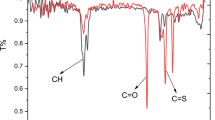Abstract
The physical and chemical properties of silver nanoparticles that are responsible for their antimicrobial activities have been studied with spherical silver nanoparticles (average diameter approximately 9 nm) synthesized by the borohydride reduction of Ag+ ions, in relation to their sensitivity to oxidation, activities towards silver-resistant bacteria, size-dependent activities, and dispersal in electrolytic solutions. Partially (surface) oxidized silver nanoparticles have antibacterial activities, but zero-valent nanoparticles do not. The levels of chemisorbed Ag+ that form on the particle’s surface, as revealed by changes in the surface plasmon resonance absorption during oxidation and reduction, correlate well with the observed antibacterial activities. Silver nanoparticles, like Ag+ in the form of AgNO3 solution, are tolerated by the bacteria strains resistant to Ag+. The antibacterial activities of silver nanoparticles are related to their size, with the smaller particles having higher activities on the basis of equivalent silver mass content. The silver nanoparticles aggregate in media with a high electrolyte content, resulting in a loss of antibacterial activities. However, complexation with albumin can stabilize the silver nanoparticles against aggregation, leading to a retention of the antibacterial activities. Taken together, the results show that the antibacterial activities of silver nanoparticles are dependent on chemisorbed Ag+, which is readily formed owing to extreme sensitivity to oxygen. The antibacterial activities of silver nanoparticles are dependent on optimally displayed oxidized surfaces, which are present in well-dispersed suspensions.



Similar content being viewed by others
Notes
The term “oxidized nano-Ag” used throughout the text denotes the partially oxidized form of nano-Ag which possesses chemisorbed Ag+ ions.
Abbreviations
- BSA:
-
Bovine serum albumin
- Hepes:
-
N-(2-Hydroxyethyl)piperazine-N′-ethanesulfonic acid
- MIC:
-
Minimum inhibitory concentration
- Nano-Ag:
-
Silver nanoparticles
- SPR:
-
Surface plasmon resonance
References
Sonnichsen C, Reinhard BM, Liphardt J, Alivisatos AP (2005) Nat Biotechnol 23:741–745
Rosi NL, Giljohann DA, Thaxton CS, Lytton-Jean AK, Han MS, Mirkin CA (2006) Science 312:1027–1030
Jin R, Cao Y, Mirkin CA, Kelly KL, Schatz GC, Zheng JG (2001) Science 294:1901–1903
Murphy CJ, Jana NR (2002) Adv Mater 14:80–82
Henglein A (1998) Chem Mater 10:444–450
Henglein A (1993) J Phy Chem 97:5457–5471
Olson ME, Wright JB, Lam K, Burrell RE (2000) Eur J Surg 166:486–489
Aymonier C, Schlotterbeck U, Antonietti L, Zacharias P, Thomann R, Tiller JC, Mecking S (2002) Chem Commun 3018–3019
Alt V, Bechert T, Steinrucke P, Wagener M, Seidel P, Dingeldein E, Domann E, Schnettler R (2004) Biomaterials 25:4383–4391
Balogh L, Swanson DR, Tomalia D, Hagnauer GL, McManus AT (2001) Nano Lett 1:18–21
Melaiye A, Sun Z, Hindi K, Milsted A, Ely D, Reneker DH, Tessier CA, Youngs WJ (2005) J Am Chem Soc 127:2285–2291
Lee D, Cohen RE, Rubner MF (2005) Langmuir 21:9651–9659
Podsiadlo P, Paternel S, Rouillard JM, Zhang Z, Lee J, Lee JW, Gulari E, Kotov NA (2005) Langmuir 21:11915–11921
Baker C, Pradhan A, Pakstis L, Pochan D J, Shah SI (2005) J Nanosci Nanotechnol 5:244–249
Sun RW, Chen R, Chung NP, Ho CM, Lin CL, Che CM (2005) Chem Commun 5059–5061
Russell AD, Hugo WB (1994) Prog Med Chem 31:351–70
Dibrov P, Dzioba J, Gosink KK, Häse CC (2002) Antimicrob Agents Chemother 46:2668–70
Bard AJ, Holt KB (2005) Biochemistry 44:13214–13223
Silver S (2003) FEMS Microbiol Rev 27:341–153
Klaus T, Joerger R, Olsson E, Granqvist CG (1999) Proc Natl Acad Sci USA 96:13611–13614
Gupta A, Matsui K, Lo JF, Silver S (1999) Nat Med 5:183–188
Li XZ, Nikaido H, Williams KE (1997) J Bacteriol 179:6127–6132
Sondi I, Salopek-Sondi B (2004) J Colloid Interface Sci 275:177–182
Morones JR, Elechiguerra JL, Cammacho A, Holt K, Kouri JB, Ramirez JT, Yacaman J (2005) Nanotechnology 16:2346–2353
Xu XH, Brownlow WJ, Kyriacou SV, Wan Q, Viola JJ (2004) Biochemistry 43:10400–10413
Lok CN, Ho CM, Chen R, He QY, Yu WY, Sun H, Tam PK, Chiu JF, Che CM (2006) J Proteome Res 5:916–924
Gibbard J (1937) Am J Public Health 27:112–119
Djokic SS, Burrell RE (1998) J Electrochem Soc 145:1426–143
Fan FR, Bard AJ (2002) J Phys Chem B 106:279–287
Panacek A, Kvitek L, Prucek R, Kolar M, Vecerova R, Pizurova N, Sharma VK, Nevecna T, Zboril R (2006) J Phys Chem B 110:16248–16253
Doty RD, Tshikhudo TR, Brust M, Fernig DG (2005) Chem Mater 17:4630–4635
Moskovits M, Vlckova B (2005) J Phys Chem B 109:14755–14758
Tian J, Wong KK, Ho CM, Lok CN, Yu WY, Che CM, Chiu JF, Tam PK (2007) Chem Med Chem 2:129–136
Acknowledgements
We thank Simon Silver, Xian-Zhi Li, and Keith Poole for providing the bacterial strains, and Rory Watt for his help in editing the manuscript. This work was supported by the Area of Excellence Scheme (AoE/P-10/01) established under the University Grants Committee of the Hong Kong Special Administrative Region, People’s Republic of China, the Strategic Research Themes on Bionanotechnology, and the Research Support Programs (to C.M.C., J.F.C., and C.N.L) and the University of Hong Kong.
Author information
Authors and Affiliations
Corresponding authors
Additional information
Chun-Nam Lok and Chi-Ming Ho equally contributed to this work.
Electronic supplementary material
Below is the link to the electronic supplementary material.
Rights and permissions
About this article
Cite this article
Lok, CN., Ho, CM., Chen, R. et al. Silver nanoparticles: partial oxidation and antibacterial activities. J Biol Inorg Chem 12, 527–534 (2007). https://doi.org/10.1007/s00775-007-0208-z
Received:
Accepted:
Published:
Issue Date:
DOI: https://doi.org/10.1007/s00775-007-0208-z




